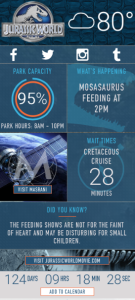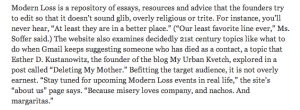Creativity

Jurassic World: The Transmedia Story Begins
1If you watched the Super Bowl, you probably already saw the ad for Jurassic World, the next sure-to-be-a-blockbuster summer movie in a franchise that continues to ask the question, “if we rebuilt the park AGAIN…would it still be a disaster?” and adds the question, “if we created an even deadlier dinosaur than a T-Rex…would that create a safe theme park environment?” While I’m guessing the answer are “yes” and “no,” respectively, from the minute I hear the John Williams score, I’m on board.
But if you’re on the electrified paddock fence about contributing your movie ticket’s cost to creating a blockbuster, Jurassic World wants you: you might not be interested in another dino-disaster flick, but could they interest you in a relaxing trip to the Hilton Isla Nublar, to enjoy the family attractions of their theme park?
Of course, Isla Nublar isn’t a real place. But that hasn’t stopped Jurassic World from launching the story of the film – which isn’t out for another 4 months – through an impressively-detailed website that mimics the life and offerings of a real-life theme park. The site features restaurant menus at the park’s dining establishments, educational materials about the dinosaurs that visitors will encounter, and “live-cam” footage from the park. If you’re really looking for it can you find the link, in tiny print, that says “visit jurassicworldmovie.com.” And if you try to “book” one of their packages – which come in Standard, Family, Adrenaline, Romance and others, each built-out and better-programmed than some conferences I’ve been to – you will get re-routed to Fandango. Otherwise, you can go about your business fantasizing about your luxurious fake-cation.
Jurassic World is creating its narrative’s world through transmedia – creating content across multiple media, in support of a story that will exist or already does exist somewhere else (at least that’s my layperson’s explanation; see here for something “more official“).
Transmedia extends the story and enables more personalized access to the narrative than a one-directional film aimed at an audience in a darkened theater could, and expands the reach of that story using different tools in the storytelling toolkit. Whether it’s webisodes that tell you more about minor characters or deepen historical backstory for a TV show or a peek inside the diary or blog of a character who’s always depicted as scribbling in a notebook, transmedia is a reward for fans who want to know more and a tool to deepen their relationship to the show. It’s like backchannel chatter among those in the know. Sharing information can be a powerful thing that builds trust and investment, creating a proud cohort of evangelists who can represent your brand even when you’re on your lunch break.
It’s become trendy to talk about “storytelling” when it comes to branding. But the word “story” itself doesn’t mean what it classically used to. Now there’s the all-access story, the story-behind-the-story, the context for the story, the story-after-the-story.
The JurassicWorld.com website may still not convince you to see Jurassic World, the movie. But if it convinces you of one thing, let it persuade you to accept that people are learning to expect a narrative that is dynamic, expanding beyond its initially perceived limits. And the most successful brands and organizations will spend the time, creativity and money to build out the universe around the main story in a way that supports their core message, whether it’s donations or dinosaurs.

March Madness: Recent Clips
0This week was simply mad – a personal essay in the JTA (commonly known as the AP of the Jewish world) about loss, focusing on a ring that was my mother’s; I attended my lovely and moving good-bye party at work; a new part-time job came together which enables me to shift into new styles of writing (more to come on that later); and over this weekend, was mentioned in an article in the New York Times about the Modern Loss site, to which I had contributed a piece titled “Deleting My Mother.” (As an extra bonus moment of glee, the Times referred to me as “founder of the blog My Urban Kvetch,” a mention I never would have imagined when I founded it ten years ago.)
Earlier in March, I read a piece about improv inspiring creativity at Jewish nonprofits, and decided to take it one step further with this piece, “Yes-And’ing Our Way to Organizational Progress.”
This past weekend was also the Jewish holiday of Purim, which is typically marked by celebration and comedic performances, including something called a “Purim shpiel” – generally this highlights the story of Purim in some way, but the spiritual community known as IKAR treats the “shpiel” time as an opportunity to lampoon the community itself. This is my second year on the writing team for the Shpiel, and one of my two contributions was a parody of pharmaceutical commercials, but treating IKAR itself as the drug. (The other one, a Yiddish-inflected parody of “Roar,” by Katy Perry, isn’t posted yet.) There’s a lot of inside comedy, but I think it still plays to others. Check it out!
LimmudLA Sessions
0This weekend, I’m presenting at LimmudLA – a number of the panels are through the “Future of Jewish L.A.” track, sponsored by the Jewish Federation of Greater Los Angeles, and then there’s the “Improv for Jews” session, which is just for fun. (And education!)
Engaging the Next Generation Meaningfully in a World of Options
When it comes to social and community connections, today’s 20-somethings and 30-somethings are overwhelmed with online and offline options. How can we provide Jewish 20s and 30s with the online resources that they need and with in-person programs that engage them socially, communally and Jewishly? Hear from some of the people who are actively engaging this population in our community.
What’s the Next Big Idea for Jewish Los Angeles?
As we open a new decade, and Federation celebrates its Centennial, what does our community need most? Join Andrew Cushnir, Esther Kustanowitz, and other innovative and creative thinkers with big ideas for the Jewish future for an inside peek at some ideas from the Next Big Jewish Idea search. Then we’ll talk about our communal needs and how we can meet them through innovative community and cultural initiatives.
“Withinnovation”: Making Institutional Room for Partnerships and Innovation
People perceive Jewish innovation and Jewish institutions as two separate entities – but they don’t have to be. In our increasingly interconnected Jewish future, community institutions like synagogues and Federations are “withinnovating” – making room for innovation within their institutions, which can present challenges to innovators and institutions alike. Explore this emerging trend with some of LA’s resident innovation experts.
Improv for Jews
What’s so Jewish about basic improv comedy? This informal, participatory workshop introduces the basics of improv comedy within a Jewish community context – suitable for Jews and Judeophiles of all ages, and no comedy experience required.
“Social Media Basics” Now Online!
0In April, I did the first of a three-part social media webinar series for the Jewish Communal Professionals of Southern California. Our focus in this session was an overview of social media and to begin the discussion of how social media can help Jewish non-profits strengthen their public profiles, promote their projects, and enhance their relationships with their clients/consumers/communities. I’m uploading finished presentations to Slideshare – feel free to check them out.
Does Your Organization Have an Anti-Innovation Checklist?
0Is your organization or boss afraid of change? Turned off by technology? Terrified by the prospect of innovation? Then he (or she, or they) might already have an ‘anti-innovation checklist” – a group of core principles and phrases that they trot out in order to discredit new ideas and creativity in favor of the status quo.
The list below comes from a Harvard Business Review post by Youngme Moon, the Donald K. David Professor of Business Administration at the Harvard Business School. What other excuses have you heard from individuals who or organizations which resist change? (My favorite is “if it ain’t broke, and even if it is, don’t fix it.”)

